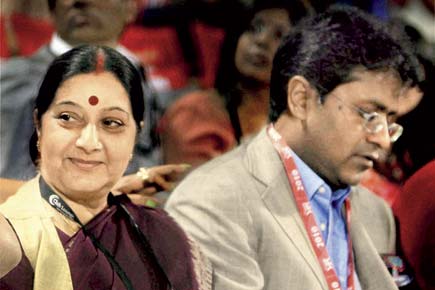It has been a busy season for news media. The kind of scams being revealed Vyapam or Lalit Modi are intriguing

 It has been a busy season for news media. The kind of scams being revealed Vyapam or Lalit Modi are intriguing. In journalistic circles, the buzz is that when information of this sort is being leaked all over the place, some power struggle is being played out through the media.
It has been a busy season for news media. The kind of scams being revealed Vyapam or Lalit Modi are intriguing. In journalistic circles, the buzz is that when information of this sort is being leaked all over the place, some power struggle is being played out through the media.
That sounds cynical but the fact is that investigative journalism, the way it was practised in the ‘60s, ‘70s or ‘80s doesn’t exist.

External Affairs Minister Sushma Swaraj with former IPL chief Lalit Modi during an IPL match in New Delhi in 2010. Both are currently embroiled in the Lalitgate controversy. Pic/PTI
Think of it which is the last newspaper/TV channel led investigative piece you have seen the Bofors, Harshad Mehta or Watergate type. Most of the documents or information comes from a source. You could argue that that happened earlier too. But most trained journalists had the good sense to question these sources and their motives and authenticate the information. It is very difficult now to get trained journalists who can question facts, figures and documents, from unofficial or official sources such as CAG.
Today, even if a journalist did sniff out a genuinely good story, there are only a handful of papers or news channels with editors and owners who have the gumption to stand by it. In the 1970s, Bob Woodward and Carl Bernstein, two reporters from The Washington Post, pieced together the evidence linking the Nixon administration to Watergate. Much of this happened, mind you, in the days before the Internet, mobile phones or other research tools that make life so much easier now for reporters. It eventually led to the indictment of forty White House and administration officials and the resignation of president Richard Nixon. What worked for the reporters was an editor (Ben Bradlee) and an owner (the late Katharine Graham), who withstood a lot of political and financial pressure to let the story be. It also meant putting in time and money into the story.
Currently, the private TV news business in India is small, unprofitable and full of brands which are in the game for influence rather than news. On the other hand, newspaper publishing is a very profitable business. While there are still many good editors and media owners in India, none have the stomach for the political and legal pressure a story like Bofors or Watergate would involve these days. Good investigative reportage works if the editor of a Mumbai-based newspaper does not end up going for dozens of appearances in a court in Siliguri or Allahabad to defend a story. This then leads to a huge amount of self-censorship by journalists and owners who want to do their job but can’t deal with the mess of a inquiry or having their licence cancelled. Or worse still, being killed.
There are a few things that could help though. Some good money spent on training journalists so that they are on legally sound ground. The opening up of the news media to higher levels of foreign investment (49 per cent instead of 26 currently) so that training, knowledge sharing and money all come into Indian media. And at least two to three not-for-profit news brands, which would push the privately-owned ones to do a better job. The taxpayer-funded BBC does that in the UK by setting a benchmark so high that others have no choice but to be half as good.
In India, the taxpayer-funded news channel Doordarshan (DD) is controlled by the central government. And irrespective of the political party in power, it has not been freed of government control. Though Prasar Bharati, the corporation which runs DD, is ‘autonomous’, its CEO cannot hire or fire people, raise money or leverage its assets to make the company efficient. The current CEO, Jawhar Sircar recently went on record on how difficult it is to run the corporation to deliver what Indians need — a good public service broadcaster.
As things stand, private media is hamstrung by poor training, hyper-competition and owners who either play the game or studiously stay out of it, and public media is hamstrung by the government. Time then for some fresh new thinking on the business of news.
The writer is a media specialist and author. Follow her on Twitter at https://twitter.com/vanitakohlik
 Subscribe today by clicking the link and stay updated with the latest news!" Click here!
Subscribe today by clicking the link and stay updated with the latest news!" Click here!









